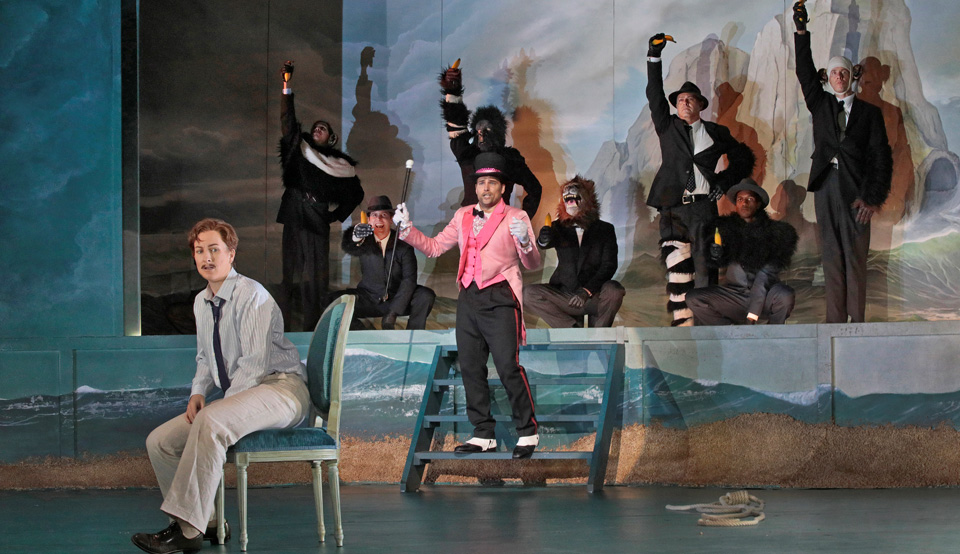
SANTA FE, N.M.—Over the past 30 years Santa Fe has returned repeatedly to the operatic works of George Frideric Handel, chronologically in order of presentation, beginning in 1987, with Ariodante, Xerxes, Semele, Agrippina, Radamisto, and this season, Alcina. The opera is sung in Italian (with captions in both English and Spanish available at each seat).
Based on an average of one Handel every five years, if SFO were to stage every one of the composer’s output of 42 operas, we’d see the last of them in the year 2197. And that’s not counting the masques, musical dramas and oratorios which sometimes get staged as well.
Considering that he is mostly known for the perennial Messiah, the “Water Music” suites that decorate public radio classical programs like wallpaper, the occasional other oratorio that pops up, out of 27 that he penned, like Alexander’s Feast, Judas Maccabaeus, or Theodora, and a few choral pieces heard either in church or on concert programs, it’s evident that there is much of his musical output that the broad concertgoing public has no handle on.
In his day, Handel was at the top of his game in opera, but by the time he died in 1759, at age 74, the kind of baroque opera he wrote—formal, static, almost all solo arias with few duets and little work for the chorus—was on the way out. His stage works sank into an oblivion that lasted until the early decades of the 20th century, when some enterprising opera presenters decided to dust off a few of his scores and try them out. Only very gradually have some of these titles become widely appreciated in opera houses around the world. Perhaps his Giulio Cesare is his most performed stage work now.
Owing to their slow, stately nature, often on classical or historical themes, with almost every aria in the standard ABA form, with greater ornamentation of the melody in the second A, these operas can barely hold the stage today if presented in a form anything like what Handel might have recognized. They simply have to be re-imagined for modern audiences, which often means severe trimming down to a palatable length, perhaps replacing duller arias with others from different Handel works, re-setting the time and place, and adjusting roles for today’s voices, a good castrato being hard to find these days (although there are some fine countertenors about).
And the stage action has to be ramped up with more of everything—movement, emotional expression, changes of scenery, striking lighting effects, interaction of characters, and possibly introduction of dancers, jugglers, acrobats or other incidental figures not in the original cast. In other words, a modern director has to perceive the potential for drama and humor in these works and milk it to the fullest.
The present Alcina, directed by David Alden, has been reconceived for Santa Fe Opera, based on a co-production of Opera National de Bordeaux and Teatro Real de Madrid. It’s in three acts of close to an hour each, with two intermissions. Opening night, on Santa Fe summer solstice time, began at 8:30; the opera did not let out until after midnight, but now, later in the season, performances begin at 8 pm. It’s still a long night.
Alcina’s libretto is anonymous, but based on Ariosto’s Orlando Furioso, a lengthy poem of chivalric romance from 1532. It was first performed at London’s Royal Covent Garden Theatre (a newer version of which still exists in the same location) on April 16, 1735. This year’s Santa Fe repertoire spans four centuries, beginning with this work up to the 2017 world premiere of The (R)evolution of Steve Jobs.
The cast comprises four principal characters and three subsidiary ones. The sorceress queen Alcina (soprano Elza van den Heever) has created an island paradise to lure her sequential lovers into her power—and when she is finished with their charms, she transforms them into natural formations such as rocks, trees or waves, or into wild animals that populate her realm. (This is where the seven-member troupe of Wise Fool New Mexico comes in, acrobats playing these simian and other fantastic creatures bouncing and breakdancing all over the stage.) It appears that Alcina acquires her lovers from shipwrecked sailors, but in any case she has the power to transport anyone from anywhere that she might desire. Her current paramour is Ruggiero (mezzo-soprano Paula Murrihy), who under Alcina’s spell, left his betrothed Bradamante (mezzo-soprano Daniela Mack). Bradamante washes up ashore with her tutor Melisso (bass-baritone Christian Van Horn) to rescue Ruggiero. On the island they find Alcina’s sister Morgana (soprano Anna Christy), who does not share Alcina’s powers but certainly envies her success with men; Alcina’s general Oronte (tenor Alek Shrader), obviously a former lover now head ape; and Oberto (soprano Jacquelyn Stucker), a boy who is lost on the island in search of his father, who is unrecognizable to him as one of the ape-men.
Now you may have noticed that two of the male roles, Ruggiero and Oberto, are performed by female singers. The original 1735 Ruggiero was performed by the popular castrato Giovanni Carestini, active in London at the time. The abandoned fiancée Bradamante comes on stage disguised as her own brother “Ricciardo,” with whom Morgana falls in love. So there is gender-bending all over the place. This is absolutely nothing new in opera, and Handel, as a cosmopolitan, influential gay man surrounded by a bevy of friends, supporters and admirers, must have felt right at home in a milieu that would, by a couple of generations later, seem rather freakish as Victorian Christian primness set in. Still, however, the operatic stage always reserved some space for cross-gender roles.
In another important respect, Alcina sets itself apart from the norm insofar as the title character, a sorceress and conjurer, is the clear subject of her sexuality, not the object of men’s gaze or power. Her wand commands all she surveys, in not so much a gender switch but a role reversal, as something of a Donna Giovanna. Yet in the end, her humanity is restored, the past lovers regain their human form, true love triumphs, and all is set right again as we are saved from “the wild.” It’s critical to recall, again, that it’s Bradamante, the fiancée, who rescues her lover (like Leonora in Beethoven’s Fidelio, and indeed like Laurene in this season’s The (R)evolution of Steve Jobs). And yet, in Alden’s vision, when all is seen and sung, there’s still a little of the ape in us, there still lingers a Betty Friedan-like discontent with socially enforced gender-typing in suburban “Dreamsville,” and we are always subject to some erotic sorcery placed upon us when we least expect it.
Alden’s conceit is that the action takes place on and around deserted old theatres, and the characters appear as vaudevillians, as ushers with flashlights, as tragic, forlorn actresses lamenting lost passion, as wanderers searching their way home, in a mashup of sartorial epochs suggesting that our issues as human beings today are not so different from those Handel depicted. The intense, side-lit shadows cast an expressionistic halo around the characters, as if to say, We are never only and entirely the people we show ourselves to be: We also own the dark shadows we throw off. Sometimes I found my eye more interested in the interaction of the shadows on the walls and stage than in the singers projecting them.
Operas in Handel’s time were raucous affairs given to latecomers, patrons frequently getting up from their seats (these long shows were performed in successive scenes but without intermissions as such), much private conversation and snacking during the performance. In addition, you could expect that rival claques supporting this or that singer would make loud huzzas for their favorites and even more vociferous tirades against their competitors.
In the end these regally staged, though chaotic presentations were always more about spectacle, with gorgeously painted scenery and effects, than story, and always more about beautiful singing than convincing characterization. In our day we want to be moved by the singer’s interpretation of a role, not simply stunned into dumb awe by superstratopheric vocalization alone.
Every one of these singers, without exception, had the chops to deliver Handel’s music, from soft, languid lamentation to spitfire bravado coloratura. But despite filling the stage with clever, constant and frequently humorous movement, the fact remained that three acts of one gorgeous jewel of an aria after another became wearisome. Not everyone has the Sitzfleisch for it—the ability to dismiss rear-end discomfort “for the duration.” A substantial segment of the audience left at the second intermission—that was already about 11 pm. I believe the production could have been tightened up by the omission of a couple of those sad laments, and by dividing the show into two approximately 1.5-hour segments, eliminating one intermission. Because those who skipped the last act surely missed some of the best stage work and singing of the night. And missed Alden’s point, too, that the romantic ideals of any particular age are always subject to criticism and change.
Conductor Harry Bicket, a specialist in baroque music, led Handel’s entrancing orchestra, a few of whose members came up on the stage to execute their solos alongside the singers, a most effective piece of direction. Malcolm Rippeth contributed the strong lighting design, and Gideon Davey provided the scenic and costume design spanning centuries. Choreography was by Beate Vollack, which I assume coordinated all the ape antics.
I attended the premiere on July 29. Future performances take place on August 11, 17, and 23 at 8:00 pm. Santa Fe Opera is seven miles north of Santa Fe on U.S. 84/285. Visit www.santafeopera.org or call (505) 986-5900 or (800) 280-4654 for information and tickets.












Comments